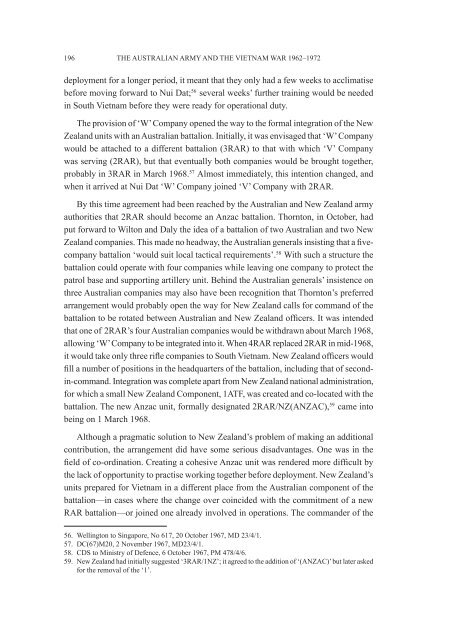conference proceedings - Australian Army
conference proceedings - Australian Army
conference proceedings - Australian Army
Create successful ePaper yourself
Turn your PDF publications into a flip-book with our unique Google optimized e-Paper software.
196<br />
THE AUSTRALIAN ARMY AND THE VIETNAM WAR 1962–1972<br />
deployment for a longer period, it meant that they only had a few weeks to acclimatise<br />
before moving forward to Nui Dat; 56 several weeks’ further training would be needed<br />
in South Vietnam before they were ready for operational duty.<br />
The provision of ‘W’ Company opened the way to the formal integration of the New<br />
Zealand units with an <strong>Australian</strong> battalion. Initially, it was envisaged that ‘W’ Company<br />
would be attached to a different battalion (3RAR) to that with which ‘V’ Company<br />
was serving (2RAR), but that eventually both companies would be brought together,<br />
probably in 3RAR in March 1968. 57 Almost immediately, this intention changed, and<br />
when it arrived at Nui Dat ‘W’ Company joined ‘V’ Company with 2RAR.<br />
By this time agreement had been reached by the <strong>Australian</strong> and New Zealand army<br />
authorities that 2RAR should become an Anzac battalion. Thornton, in October, had<br />
put forward to Wilton and Daly the idea of a battalion of two <strong>Australian</strong> and two New<br />
Zealand companies. This made no headway, the <strong>Australian</strong> generals insisting that a fivecompany<br />
battalion ‘would suit local tactical requirements’. 58 With such a structure the<br />
battalion could operate with four companies while leaving one company to protect the<br />
patrol base and supporting artillery unit. Behind the <strong>Australian</strong> generals’ insistence on<br />
three <strong>Australian</strong> companies may also have been recognition that Thornton’s preferred<br />
arrangement would probably open the way for New Zealand calls for command of the<br />
battalion to be rotated between <strong>Australian</strong> and New Zealand officers. It was intended<br />
that one of 2RAR’s four <strong>Australian</strong> companies would be withdrawn about March 1968,<br />
allowing ‘W’ Company to be integrated into it. When 4RAR replaced 2RAR in mid-1968,<br />
it would take only three rifle companies to South Vietnam. New Zealand officers would<br />
fill a number of positions in the headquarters of the battalion, including that of secondin-command.<br />
Integration was complete apart from New Zealand national administration,<br />
for which a small New Zealand Component, 1ATF, was created and co-located with the<br />
battalion. The new Anzac unit, formally designated 2RAR/NZ(ANZAC), 59 came into<br />
being on 1 March 1968.<br />
Although a pragmatic solution to New Zealand’s problem of making an additional<br />
contribution, the arrangement did have some serious disadvantages. One was in the<br />
field of co-ordination. Creating a cohesive Anzac unit was rendered more difficult by<br />
the lack of opportunity to practise working together before deployment. New Zealand’s<br />
units prepared for Vietnam in a different place from the <strong>Australian</strong> component of the<br />
battalion—in cases where the change over coincided with the commitment of a new<br />
RAR battalion—or joined one already involved in operations. The commander of the<br />
56. Wellington to Singapore, No 617, 20 October 1967, MD 23/4/1.<br />
57. DC(67)M20, 2 November 1967, MD23/4/1.<br />
58. CDS to Ministry of Defence, 6 October 1967, pM 478/4/6.<br />
59. New Zealand had initially suggested ‘3RAR/1NZ’; it agreed to the addition of ‘(ANZAC)’ but later asked<br />
for the removal of the ‘1’.

















